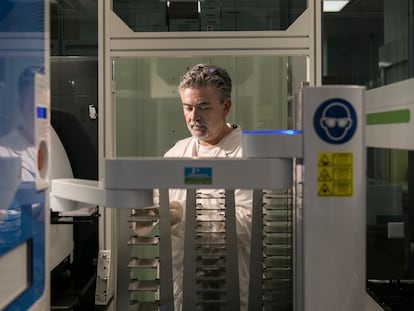New treatments for cancer: TILs and Trojan horses
The survivability of certain types of cancers is improving but more focus and investment in prevention is needed


Over the past few decades, medical advances have extended the life expectancies of people with many types of cancer. Improvements in early diagnosis and in surgical and radiation procedures, as well as the development of new treatments, have meant that the survivability rate for breast and prostate cancer now exceeds 80%, depending on the stage at which it is detected. This success is encouraging for people suffering from other types of cancers. Lung cancer now has a survivability rate of 20%, which is up 15% over the last decade.
At the 2022 meeting of the European Society of Oncology (ESMO), (attended by EL PAÍS at the invitation of AstraZeneca), some of the presentations discussed the improved prognosis for some types of cancerous tumors. One study revealed better treatments for patients with ovarian cancer, which has a low survivability rate. The results of a phase 3 SOLO1 study show that 67% of ovarian cancer patients with mutated BRCA genes (which increases cancer risk) who were administered Olaparib (a group of drugs known as PARP inhibitors), were alive after seven years. Luis Manso, an expert in gynecologic cancers at the 12 de Octubre Hospital in Madrid who did not participate in the study, believes that this treatment “is a step towards a total cure.”
Cancer tumors are no longer categorized by the organs in which they grow. The genetic mutations that determine the tumor’s characteristics are now a primary consideration. This led oncologists to treat lung cancer with drugs developed for breast cancer – a combination of trastuzumab (a drug that targets malignant cells with the HER2 protein) and deruxtecan (a potent chemotherapy drug). The first drug enables the precise targeting of the cancerous cells, and the second drug destroys them in a controlled manner, without harming healthy cells. Although the results were less striking than in breast cancer, a presentation at ESMO 2022 showed how this type of “Trojan horse” drug can be used against lung tumors with the HER2 protein. The study also demonstrated the importance of first conducting molecular tests to detect mutations that respond to specific drugs before starting treatment. These tests enable doctors to precisely identify the type of tumor they must treat, providing much more information than just the tumor’s location and appearance.
One of the most promising new applications of an existing cell therapy is the use of chimeric antigen receptor (CAR) T-cell therapy developed for blood cancers like leukemia, to treat solid tumors like skin cancers. In a clinical trial supported by the Dutch government, John Haanen of the Netherlands Cancer Institute in Amsterdam found that patients who received injections of TILs (tumor-infiltrating lymphocytes) for metastatic melanoma were 50% less likely to die from the disease than patients treated with ipilimumab, an immunotherapy drug.
The technique consists of taking a sample of the cancerous tumor and extracting lymphocytes that have been in contact with the malignant cells and can recognize them. These trained cells are then cultured in the laboratory so they can be replicated and subsequently injected into the patient. Overall, the median survival period of people who received this treatment was 25.8 months, compared to 18.9 months with immunotherapy, for a type of tumor that was virtually untreatable until 10 years ago.
Haanen said: “We can now offer TIL treatment as an alternative for patients with metastatic melanoma.” Haanen and his team now want to seek approval for the treatment from the European Medicines Agency (EMA) to make sure it remains affordable and free from commercial pressures. Some of these cell therapies can cost hundreds of thousands of dollars when they have been developed by the pharmaceutical industry, but patients can be treated for less than $100,000 when the cell therapy has been developed in academic and public settings.

Despite the new treatment approaches and improved survivability of many types of cancer gained over the last 20 years, their high cost and an aging population may jeopardize their widespread application. For this reason, many of the ESMO Congress presenters emphasized the need for more focus and resources for cancer prevention. A meeting of lung cancer specialists discussed strategies for standardizing lung cancer screenings so that they become as routine as colon and breast cancer screenings for people of a certain age and with risk factors. Luis Paz Ares, the head of oncology at the 12 de Octubre Hospital in Madrid, estimates that “of the 25,000 people who die of lung cancer every year in Spain, 6,000 could be saved” by early detection.
Paz, who is also president of the Spanish Association for Cancer Research (ASEICA), wants more emphasis on medications, facilities and treatments for smoking cessation. “This isn’t even provided for people with a very urgent need, such as those who have suffered heart attacks,” said Paz, who believes that people should place tobacco “on the same level as cocaine and heroin.” According to his estimates, “If everyone stopped smoking today, lung cancer would drop by 80% and other types of tumors by around 30%.” However, he admits that there is no data indicating how much of the money spent on cancer treatment is for prevention.
While increased funding for developing cancer treatments has produced good results, people should undoubtedly try to avoid the need for these treatments. Public policies that encourage less alcohol, tobacco and ultra-processed food consumption should be reinforced. One of the most discussed presentations at ESMO 2022 was the one by Charles Swanton (The Francis Crick Institute, London), which found that small particles in urban air pollution can cause lung cancer in people who have never smoked.
The studies conducted by Swanton and his team observed that some mutations commonly found in lung cancer are also found in healthy tissue, probably as a consequence of aging. Swanton noted that these mutations alone do not usually lead to cancerous tumor growth, but when cells with these mutations were exposed to particles in urban air pollution, the likelihood of carcinogenic cell development increased.
This type of research supports the claim that pollution from car exhaust, for example, increases the risk of lung cancer, even for non-smokers. This evidence should justify reducing one’s exposure to these pollutants. “The same air particulates produced by burning fossil fuels that are intensifying climate change, are having a direct impact on human health through the biological mechanism we observed,” said Swanton. “The risk of lung cancer from pollution is lower than from smoking, but we have no control over what we breathe.”
Tu suscripción se está usando en otro dispositivo
¿Quieres añadir otro usuario a tu suscripción?
Si continúas leyendo en este dispositivo, no se podrá leer en el otro.
FlechaTu suscripción se está usando en otro dispositivo y solo puedes acceder a EL PAÍS desde un dispositivo a la vez.
Si quieres compartir tu cuenta, cambia tu suscripción a la modalidad Premium, así podrás añadir otro usuario. Cada uno accederá con su propia cuenta de email, lo que os permitirá personalizar vuestra experiencia en EL PAÍS.
¿Tienes una suscripción de empresa? Accede aquí para contratar más cuentas.
En el caso de no saber quién está usando tu cuenta, te recomendamos cambiar tu contraseña aquí.
Si decides continuar compartiendo tu cuenta, este mensaje se mostrará en tu dispositivo y en el de la otra persona que está usando tu cuenta de forma indefinida, afectando a tu experiencia de lectura. Puedes consultar aquí los términos y condiciones de la suscripción digital.
More information
Últimas noticias
Most viewed
- Sinaloa Cartel war is taking its toll on Los Chapitos
- Oona Chaplin: ‘I told James Cameron that I was living in a treehouse and starting a permaculture project with a friend’
- Reinhard Genzel, Nobel laureate in physics: ‘One-minute videos will never give you the truth’
- Why the price of coffee has skyrocketed: from Brazilian plantations to specialty coffee houses
- Silver prices are going crazy: This is what’s fueling the rally










































